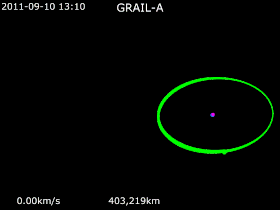
GRAIL-A · Moon · Earth
A low-energy transfer, or low-energy trajectory, is a route in space that allows spacecraft to change orbits using significantly less fuel than traditional transfers.[1][2] These routes work in the Earth–Moon system and also in other systems, such as between the moons of Jupiter. The drawback of such trajectories is that they take longer to complete than higher-energy (more-fuel) transfers, such as Hohmann transfer orbits.
Low-energy transfers are also known as Weak Stability Boundary trajectories, and include ballistic capture trajectories.
Low-energy transfers follow special pathways in space, sometimes referred to as the Interplanetary Transport Network. Following these pathways allows for long distances to be traversed for little change in velocity, or delta-v.
YouTube Encyclopedic
-
1/5Views:4 5331 28165 358103 3941 403
-
Designing low energy capture transfers for spacecraft to the Moon and Mars - Edward Belbruno
-
Low-energy transfer to type-C orbit for polar Earth observation
-
Easy Orbital Mechanics II - Hohmann Transfers
-
Why Spacecraft Are Using These Crazy Routes To The Moon - Weak Stability and Ballistic Capture.
-
Low Thrust Propulsion
Transcription
Example missions
Missions that have used low-energy transfers include:
- Hiten, from JAXA
- SMART-1, from ESA
- Genesis, from NASA.[3]
- GRAIL, from NASA.[4][5]
- Danuri from KARI[6]
On-going missions that uses low-energy transfers include:
Proposed missions using low-energy transfers include:
History
Low-energy transfers to the Moon were first demonstrated in 1991 by the Japanese spacecraft Hiten, which was designed to swing by the Moon but not to enter orbit. The Hagoromo subsatellite was released by Hiten on its first swing-by and may have successfully entered lunar orbit, but suffered a communications failure.
Edward Belbruno and James Miller of the Jet Propulsion Laboratory had heard of the failure, and helped to salvage the mission by developing a ballistic capture trajectory that would enable the main Hiten probe to itself enter lunar orbit. The trajectory they developed for Hiten used Weak Stability Boundary Theory and required only a small perturbation to the elliptical swing-by orbit, sufficiently small to be achievable by the spacecraft's thrusters.[1] This course would result in the probe being captured into temporary lunar orbit using zero delta-v, but required five months instead of the usual three days for a Hohmann transfer.[8]
Delta-v savings
From low Earth orbit to lunar orbit, the delta-v savings approach 25% on the burn applied after leaving low Earth orbit, compared to the retrograde burn applied near the Moon in the traditional trans-lunar injection, and allow for a doubling of payload.[9]
Robert Farquhar had described a 9-day route from low earth orbit to lunar capture that takes 3.5 km/s.[10] Belbruno's routes from low Earth orbit require a 3.1 km/s burn for trans lunar injection, a delta-v saving of not more than 0.4 km/s. However, the latter require no large delta-v change after leaving low Earth orbit, which may have operational benefits if using an upper stage with limited restart or in-orbit endurance capability, which would require the spacecraft to have a separate main propulsion system for capture.[11]
For rendezvous with the Martian moons, the savings are 12% for Phobos and 20% for Deimos. Rendezvous is targeted because the stable pseudo-orbits around the Martian moons do not spend much time within 10 km of the surface.[12]
See also
References
- ^ a b Belbruno, Edward (2004). Capture Dynamics and Chaotic Motions in Celestial Mechanics: With Applications to the Construction of Low Energy Transfers. Princeton University Press. p. 224. ISBN 978-0-691-09480-9.
- ^ Belbruno, Edward (2007). Fly Me to the Moon: An Insider's Guide to the New Science of Space Travel. Princeton University Press. pp. 176. ISBN 978-0-691-12822-1.
- ^ Interplanetary Superhighway Makes Space Travel Simpler // NASA 07.17.02: "Lo conceived the theory of the Interplanetary Superhighway. Lo and his colleagues have turned the underlying mathematics of the Interplanetary Superhighway into a tool for mission design called "LTool," ... The new LTool was used by JPL engineers to redesign the flight path for the Genesis mission"
- ^ "GRAIL Design at MIT Website". Retrieved 2012-01-22.
- ^ "Spaceflight101 GRAIL Mission Design". Archived from the original on 2012-07-19. Retrieved 2012-01-22.
- ^ "Danuri all set for Korea's first moon exploration". www.kari.re.kr. 6 June 2022. Retrieved 2022-07-30.
- ^ "BepiColombo overview". www.esa.int. Retrieved 2019-12-03.
- ^ Frank, Adam (September 1994). "Gravity's Rim". Discover.
- ^ Edward A. Belbruno & John P. Carrico (2000). "Calculation of Weak Stability Boundary Ballistic Lunar Transfer Trajectories" (PDF). AIAA/AAS Astrodynamics Specialist Conference.
- ^ Farquhar, Robert (1971). "THE UTILIZATION OF HALO ORBITS IN ADVANCED LUNAR OPERATIONS" (PDF). www.lpi.usra.edu. Retrieved 2020-08-02.
- ^ Parker, Jeffrey; Anderson, Rodney (25 June 2014). Low-Energy Lunar Trajectory Design. p. 24. ISBN 9781118855317.
- ^ A. L. Genova; S. V. Weston & L. J. Simurda (2011). "Human & robotic mission applications of low-energy transfers to Phobos & Deimos" (PDF). Archived from the original (PDF) on April 25, 2012.
External links
- Celestial Mechanics Theory Meets the Nitty-Gritty of Trajectory Design
- Earth-to-Moon Low Energy Transfers Targeting L1 Hyperbolic Transit Orbit June 2005
- Low Energy Trajectories and Chaos: Applications to Astrodynamics and Dynamical Astronomy
- Navigating Celestial Currents
